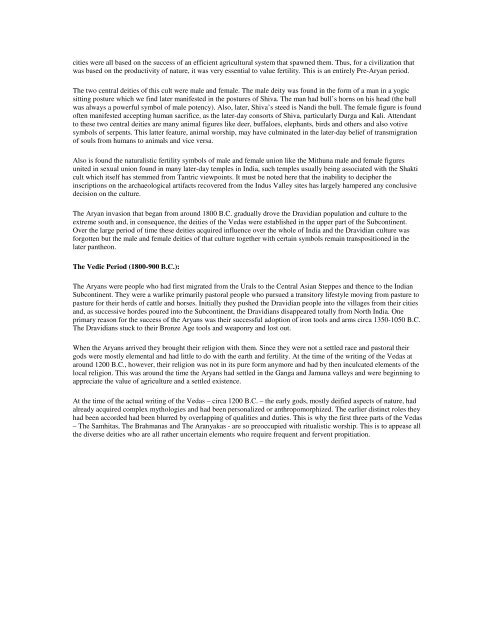Create successful ePaper yourself
Turn your PDF publications into a flip-book with our unique Google optimized e-Paper software.
cities were all based on the success of an efficient agricultural system that spawned them. Thus, for a civilization that<br />
was based on the productivity of nature, it was very essential to value fertility. This is an entirely Pre-Aryan period.<br />
The two central deities of this cult were male and female. The male deity was found in the form of a man in a yogic<br />
sitting posture which we find later manifested in the postures of Shiva. The man had bull’s horns on his head (the bull<br />
was always a powerful symbol of male potency). Also, later, Shiva’s steed is Nandi the bull. The female figure is found<br />
often manifested accepting human sacrifice, as the later-day consorts of Shiva, particularly Durga and Kali. Attendant<br />
to these two central deities are many animal figures like deer, buffaloes, elephants, birds and others and also votive<br />
symbols of serpents. This latter feature, animal worship, may have culminated in the later-day belief of transmigration<br />
of souls from humans to animals and vice versa.<br />
Also is found the naturalistic fertility symbols of male and female union like the Mithuna male and female figures<br />
united in sexual union found in many later-day temples in India, such temples usually being associated with the Shakti<br />
cult which itself has stemmed from Tantric viewpoints. It must be noted here that the inability to decipher the<br />
inscriptions on the archaeological artifacts recovered from the Indus Valley sites has largely hampered any conclusive<br />
decision on the culture.<br />
The Aryan invasion that began from around 1800 B.C. gradually drove the Dravidian population and culture to the<br />
extreme south and, in consequence, the deities of the Vedas were established in the upper part of the Subcontinent.<br />
Over the large period of time these deities acquired influence over the whole of India and the Dravidian culture was<br />
forgotten but the male and female deities of that culture together with certain symbols remain transpositioned in the<br />
later pantheon.<br />
The Vedic Period (1800-900 B.C.):<br />
The Aryans were people who had first migrated from the Urals to the Central Asian Steppes and thence to the Indian<br />
Subcontinent. They were a warlike primarily pastoral people who pursued a transitory lifestyle moving from pasture to<br />
pasture for their herds of cattle and horses. Initially they pushed the Dravidian people into the villages from their cities<br />
and, as successive hordes poured into the Subcontinent, the Dravidians disappeared totally from North India. One<br />
primary reason for the success of the Aryans was their successful adoption of iron tools and arms circa 1350-1050 B.C.<br />
The Dravidians stuck to their Bronze Age tools and weaponry and lost out.<br />
When the Aryans arrived they brought their religion with them. Since they were not a settled race and pastoral their<br />
gods were mostly elemental and had little to do with the earth and fertility. At the time of the writing of the Vedas at<br />
around 1200 B.C., however, their religion was not in its pure form anymore and had by then inculcated elements of the<br />
local religion. This was around the time the Aryans had settled in the Ganga and Jamuna valleys and were beginning to<br />
appreciate the value of agriculture and a settled existence.<br />
At the time of the actual writing of the Vedas – circa 1200 B.C. – the early gods, mostly deified aspects of nature, had<br />
already acquired complex mythologies and had been personalized or anthropomorphized. The earlier distinct roles they<br />
had been accorded had been blurred by overlapping of qualities and duties. This is why the first three parts of the Vedas<br />
– The Samhitas, The Brahmanas and The Aranyakas - are so preoccupied with ritualistic worship. This is to appease all<br />
the diverse deities who are all rather uncertain elements who require frequent and fervent propitiation.
















